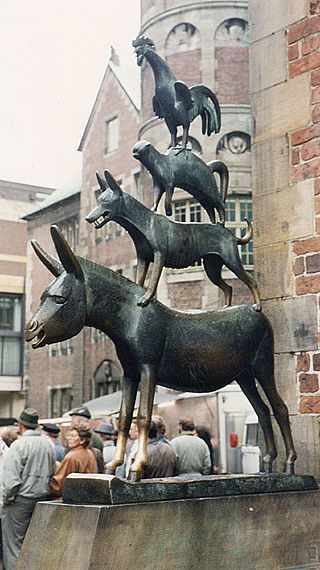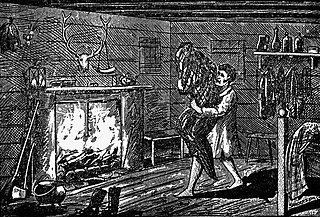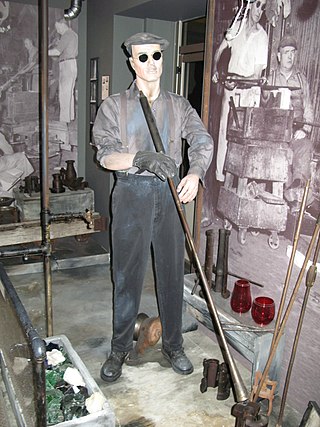Related Research Articles

In folklore, a werewolf, or occasionally lycanthrope, is an individual that can shapeshift into a wolf, either purposely or after being placed under a curse or affliction with the transformations occurring on the night of a full moon. Early sources for belief in this ability or affliction, called lycanthropy, are Petronius (27–66) and Gervase of Tilbury (1150–1228).

The figure of Mother Goose is the imaginary author of a collection of French fairy tales and later of English nursery rhymes. As a character, she appeared in a song, the first stanza of which often functions now as a nursery rhyme. This, however, was dependent on a Christmas pantomime, a successor to which is still performed in the United Kingdom.

The Duck family is a fictional family of cartoon ducks related to Disney character Donald Duck. The family is also related to the Coot, Goose, and Gander families, as well as the Scottish Clan McDuck. Besides Donald, the best-known members of the Duck family are Huey, Dewey, and Louie, Donald's three triplet nephews.
Aradia is one of the principal figures in the American folklorist Charles Godfrey Leland's 1899 work Aradia, or the Gospel of the Witches, which he believed to be a genuine religious text used by a group of pagan witches in Tuscany, a claim that has subsequently been disputed by other folklorists and historians. In Leland's Gospel, Aradia is portrayed as a messiah who was sent to Earth in order to teach the oppressed peasants how to perform witchcraft to use against the Roman Catholic Church and the upper classes.

In Gaelic myth, the Cailleach is a divine hag and ancestor, associated with the creation of the landscape and with the weather, especially storms and winter. The word literally means 'old woman, hag', and is found with this meaning in modern Irish and Scottish Gaelic, and has been applied to numerous mythological and folkloric figures in Ireland, Scotland, and the Isle of Man. In modern Irish folklore studies, she is sometimes known as The Hag of Beara, while in Scotland she is known as Beira, Queen of Winter.


In mythology, folklore and speculative fiction, shape-shifting is the ability to physically transform oneself through an inherently superhuman ability, divine intervention, demonic manipulation, sorcery, spells or having inherited the ability. The idea of shape-shifting is in the oldest forms of totemism and shamanism, as well as the oldest existent literature and epic poems such as the Epic of Gilgamesh and the Iliad. The concept remains a common literary device in modern fantasy, children's literature and popular culture.

In European folklore of the medieval and early modern periods, familiars were believed to be supernatural entities or spiritual guardians that would protect and/or assist witches and cunning folk in their practice of magic. According to records of the time, those alleging to have had contact with familiar spirits reported that they could manifest as numerous forms, usually as an animal, but sometimes as a human or humanoid figure, and were described as "clearly defined, three-dimensional... forms, vivid with colour and animated with movement and sound", as opposed to descriptions of ghosts with their "smoky, undefined form[s]".

The Bell Witch or Bell Witch Haunting is a legend from Southern United States folklore, centered on the 19th-century Bell family of northwest Robertson County, Tennessee. Farmer John Bell Sr. resided with his family along the Red River in an area currently near the town of Adams. According to legend, from 1817 to 1821, his family and the local area came under attack by a mostly invisible entity that was able to speak, affect the physical environment, and shapeshift. Some accounts record the spirit also to have been clairvoyant and capable of crossing long distances with superhuman speed.

Wallaceburg is an unincorporated community in the municipality of Chatham-Kent in Southern (Southwestern) Ontario, Canada. Originally a small settlement, it was recognized for its significant contribution to the lumber and boat building industries and strategic location along the banks of the scenic Sydenham River. In more recent years, 1895–1999, the town was known for its glass making industry. For that reason, Wallaceburg is locally known as the "glass town of Canada."
The baobhan sith is a female fairy in the folklore of the Scottish Highlands, though they also share certain characteristics in common with the succubus. They appear as beautiful women who seduce their victims before attacking them and killing them.

"The Twelve Dancing Princesses" is a German fairy tale collected by the Brothers Grimm and published in Grimm's Fairy Tales in 1815. It is of Aarne-Thompson type 306.
Libahunt is the name of a 1912 play by August Kitzberg, and a 1968 film of the same name based on the play.

Shita-kiri Suzume, translated literally into "Tongue-Cut Sparrow", is a traditional Japanese fable telling of a kind old man, his avaricious wife and an injured sparrow. The story explores the effects of greed, friendship and jealousy on the characters.

The Last Wish is the third published short story collection in Polish fantasy writer Andrzej Sapkowski's The Witcher series. Published by SuperNowa in 1993, it was preceded by 1992's Sword of Destiny, but is officially considered the first entry in the series and Sword of Destiny the second. The collection contains seven short stories interspersed with a continuing frame story: Geralt of Rivia, after having been injured in battle, rests in a temple. During that time he has flashbacks to recent events in his life, with each flashback forming a short story.

The Wallaceburg and District Museum is located in Southern Ontario in the town of Wallaceburg. Located a half-block from the banks of the Sydenham River, the museum occupies the former Wallaceburg Hydro Office at 505 King Street. The museum opened on June 29, 1984. The museum documents the beginning of the Wallaceburg community from the founding of the Baldoon Settlement by Lord Selkirk in 1804 to its success as an industrial hub in the mid-1900s.

A hag is a wizened old woman, or a kind of fairy or goddess having the appearance of such a woman, often found in folklore and children's tales such as "Hansel and Gretel". Hags are often seen as malevolent, but may also be one of the chosen forms of shapeshifting deities, such as The Morrígan or Badb, who are seen as neither wholly benevolent nor malevolent.

Blair Witch is a survival horror video game developed by Bloober Team based on the Blair Witch series of horror films. It was published by Lionsgate Games for Microsoft Windows, Xbox One and Xbox Game Pass on August 30, 2019. The game is set in 1996, two years after the events of The Blair Witch Project. The game follows former police officer Ellis Lynch as he joins the search in Black Hills Forest for a missing boy. The game was later ported to PlayStation 4, Nintendo Switch, Oculus Quest & Quest 2 and Amazon Luna throughout 2019-21.
Folk horror is a subgenre of horror film and horror fiction that uses elements of folklore to invoke fear and foreboding. Typical elements include a rural setting, isolation, and themes of superstition, folk religion, paganism, sacrifice and the dark aspects of nature. Although related to supernatural horror film, folk horror usually focuses on the beliefs and actions of people rather than the supernatural, and often deals with naïve outsiders coming up against these. The British films Blood on Satan's Claw (1971), The Wicker Man (1973) and Witchfinder General (1968) are regarded as pioneers of the genre, while the 2019 film Midsommar sparked renewed interest in folk horror. Southeast Asian cinema also commonly features folk horror.
References
- ↑ Edith Fowke (1988). Canadian folklore. Oxford University Press, Incorporated. ISBN 978-0-19-540671-9.
- ↑ Duquette, Tom (Sep 26, 1964). "Famous Baldoon Mystery - Strange story adds to area folklore". The Windsor Star. Retrieved 1 September 2011.